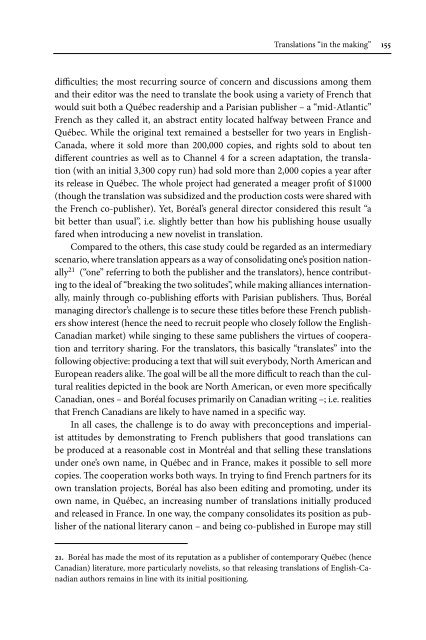Constructing a Sociology of Translation.pdf
Constructing a Sociology of Translation.pdf
Constructing a Sociology of Translation.pdf
- No tags were found...
Create successful ePaper yourself
Turn your PDF publications into a flip-book with our unique Google optimized e-Paper software.
<strong>Translation</strong>s “in the making” 155difficulties; the most recurring source <strong>of</strong> concern and discussions among themand their editor was the need to translate the book using a variety <strong>of</strong> French thatwould suit both a Québec readership and a Parisian publisher – a “mid-Atlantic”French as they called it, an abstract entity located halfway between France andQuébec. While the original text remained a bestseller for two years in English-Canada, where it sold more than 200,000 copies, and rights sold to about tendifferent countries as well as to Channel 4 for a screen adaptation, the translation(with an initial 3,300 copy run) had sold more than 2,000 copies a year afterits release in Québec. The whole project had generated a meager pr<strong>of</strong>it <strong>of</strong> $1000(though the translation was subsidized and the production costs were shared withthe French co-publisher). Yet, Boréal’s general director considered this result “abit better than usual”, i.e. slightly better than how his publishing house usuallyfared when introducing a new novelist in translation.Compared to the others, this case study could be regarded as an intermediaryscenario, where translation appears as a way <strong>of</strong> consolidating one’s position nationally21 (“one” referring to both the publisher and the translators), hence contributingto the ideal <strong>of</strong> “breaking the two solitudes”, while making alliances internationally,mainly through co-publishing efforts with Parisian publishers. Thus, Boréalmanaging director’s challenge is to secure these titles before these French publishersshow interest (hence the need to recruit people who closely follow the English-Canadian market) while singing to these same publishers the virtues <strong>of</strong> cooperationand territory sharing. For the translators, this basically “translates” into thefollowing objective: producing a text that will suit everybody, North American andEuropean readers alike. The goal will be all the more difficult to reach than the culturalrealities depicted in the book are North American, or even more specificallyCanadian, ones – and Boréal focuses primarily on Canadian writing –; i.e. realitiesthat French Canadians are likely to have named in a specific way.In all cases, the challenge is to do away with preconceptions and imperialistattitudes by demonstrating to French publishers that good translations canbe produced at a reasonable cost in Montréal and that selling these translationsunder one’s own name, in Québec and in France, makes it possible to sell morecopies. The cooperation works both ways. In trying to find French partners for itsown translation projects, Boréal has also been editing and promoting, under itsown name, in Québec, an increasing number <strong>of</strong> translations initially producedand released in France. In one way, the company consolidates its position as publisher<strong>of</strong> the national literary canon – and being co-published in Europe may still21. Boréal has made the most <strong>of</strong> its reputation as a publisher <strong>of</strong> contemporary Québec (henceCanadian) literature, more particularly novelists, so that releasing translations <strong>of</strong> English-Canadianauthors remains in line with its initial positioning.
















